We'd been so entranced with the Wild Atlantic Way, we wanted to see so much more of the southern coast so began driving west along the Beara Peninsula with the goal of reaching Dursey Island via the country's only cable car. I loved this heathery color of the shrubs along the roads especially as I happened to bring yarn that same color from home to begin knitting an afghan since we're in the car so much!
The sheep with the turquoise markings so as to not to mix him up with another farmer's sure stood out atop the rocks at Lauragh.
We wished there were people we could have asked what sort of fish traps these were in Ardgroom Harbor as we had no knowledge of what sort of fish were being caught.
The Viking Age was from 800-1150 and during that time they used Dursey Island as a slave depot where they held their Irish slaves there until they had enough to fill a ship to go home to Scandinavia. We hadn't known that there had been a monastic chapel on the island already in ruins by 1602 that had been built by a Spanish bishop before it was dismantled by pirates.
The people on Dursey Island have lived from the sea and the land for over 400 years. In the winter months, fishermen from Dursey fished the mackerel and herring and lobsters and crab over the summer months. Before the first car opened in 1969, people and livestock had to cross the treacherous Dursey Sound by boat. The island could be cut off for weeks in bad weather. The priest used to have to bless the islanders by making a sign of the cross from the mainland!
I know we weren't the only ones taking the cable car who looked a tad skeptically at the wires and rickety cable car, hoping nothing would break while they were on it!
The Vikings named Dursey, the island of the bull. Ships later relied on Calf Rock Lighthouse to guide them around the treacherous rocks. In 1881, a huge wave swept away part of the lighthouse leaving six men marooned. Twelve stormy days later, local fishermen in three boats hauled the men off the island with a rope. The sight of the sheepdog while on the ride back to the mainland was like a sign for us!
As we returned to Kenmare, the smell of he sea was especially strong for some reason just at tiny Alihies.
Evan would take turns having Kate search for the sheep who were all over the place, then corral them in one spot, then herd the sheep to the left, then to the right with exacting precision. Evan would direct Kate where exactly to go each time with very few voice commands, like saying 'away' if Evan wanted Kate to move to the right, etc.
The sheep on the left was a Lowland sheep and the horned one was either a Cheriot or Suffolk.
We walked to the barn to watch sheep shearing next.
The park's old growth oak, alder and yew groves were the best preserved in Ireland. This is what the country would have looked like 8,000 years ago before Neolithic man began rudimentary slash and burn farming and later English colonial harvesting of timber contributed to Ireland'd having the smallest percentage of forested land of any EU nation at just 10.5 percent.
The sheep with the turquoise markings so as to not to mix him up with another farmer's sure stood out atop the rocks at Lauragh.
In the middle of nowhere - but that may have been the purpose - was the Dzogchen Beara, a Tibetan Buddhist Center that was established in 1987. As we're heading to Tibet next April as part of a very long Asia trip, we figured we'd have our fill of Buddhist centers then so gave this one a pass.
Almost as pretty as a postcard, don't you think?! The wild and beautiful Beara Peninsula had something for everyone: cute fishing villages, very hilly terrain, and farmland with sheep galore.
We'd driven for 90 minutes or so along the northern part of the peninsula to reach the tip and to catch views of Dursey Island across the straight. Catching sight of the oldest cable car either of us could remember seeing we wondered just for a moment if we really wanted to take a chance riding it across to the island!
New York was but 4,950 kms away from this deserted spot that didn't have one shop, one cafe - nothing at the end of the road at all!
There was only room in the single cable car for five or six people in it, so we had to wait our turn after we arrived for it to take others across to the island and then turn around for the car to return immediately.
Steven always feels the cold far worse than I do, thus the reason he was all bundled up in all the cold weather gear he had. Despite the glorious sunny weather and cloud free skies, the wind was strong so close to the cliffs.
Once we saw the cable car make the return journey, we knew to walk back up the hill to the small station so we could also spend some time in the island.
As Dursey is the last place in Europe where the sun sets, it was featured on TV sets to mark Y2K on December 31st, 1999!
From both our recollections, there was only an operator on the mainland side who ran it nonstop so, when it arrived, we jumped in with a family of three, closed the latch and were off without the benefit of any lift operator or safety instructions, etc! It was all very low key and sort of buyer beware in hindsight.
I know we weren't the only ones taking the cable car who looked a tad skeptically at the wires and rickety cable car, hoping nothing would break while they were on it!
I'm sure you guessed by now that since we were in Ireland those white blobs on the hillside were sheep!
Despite any misgivings we may have had, we did arrive on the island perfectly safe and sound and ready to go for a walk up the hills. There were tracks in the grass we followed but certainly nothing like organized trails. We were free to wander wherever we felt like it which was very liberating.
The hills weren't alive with the 'sound of music' but they did have the same sort of 'come hither look' of inviting us to explore if I were to let my imagination roam. The vision of the sun shining, the endless grassy hills that seemed to go forever, the gorse growing a mustard color in patches, and the sheep roaming the hillside at will were a sight among the most beautiful natural sights anywhere in the world. If you've been following these blogs over the years, you know we've been to a huge number of places in this vast world, yet this was one of my favorites.
Before we crossed over to Dursey we'd read a sign that remarked about the birds we might see there. Unfortunately, we only caught sight of these choughs, members of the crow family that live along the Beara coastline. They inhabit windswept coastal regions of Ireland giving them the name of 'sea crows.'
A look back at the mainland which of course was also an island!
Gloria: Notice I was wearing the very soft yellow T-shirt I bought when I went shopping with you and Mimi in Ottawa a few weeks previously?
Suellen: I bought my knitting over to the island, not having any idea in advance how often the cable car might run, and decided to plop myself down on a rock with the sheep as my company and knitted several rows of your afghan pattern while Steven continued hiking up to the top of the hill! It was such an incredibly peaceful time and one of the quietest places on earth I can remember being.
The Slieve Mishkish Mountains cut across the Beara peninsula. They weren't quite our Colorado Rockies but very impressive in their own stark beauty.
How easy, I wondered, was it to remove the dyed wool when the wool was sold?!
Views north of Kenmare toward Killarney National Park reminded us of how quickly the land changed once we drive just a few kilometers inland!
We took a chance stopping at the Kissane Sheep Farm south of Killarney hoping there would a sheep herding demonstration sometime soon. We were delighted when we found out they were expecting a tour bus in the next five minutes and would then start the sheep herding and sheep shearing. The farm has over 1,000 sheep; these ones were were born in March or April, the normal lambing season.
The mountain in the center was called Black Wellie.
Once the tour bus disgorged its occupants, the sheep herding demonstration began with Evan, the caller, directing his own border collie, Kate, to find the sheep who were in a pretty big expanse of land. The 150 year-old Kissane farm had 2,500 acres and was still owned by the same family after six generations of sheep farming.
It was wildly fun watching Kate who had only been trained by Evan react immediately to everything Evan said who was only a few feet from us as Kate could hear Evan up to a half mile away!
Evan would take turns having Kate search for the sheep who were all over the place, then corral them in one spot, then herd the sheep to the left, then to the right with exacting precision. Evan would direct Kate where exactly to go each time with very few voice commands, like saying 'away' if Evan wanted Kate to move to the right, etc.
'Come by' meant for Kate to move to the left. Kate could manage up to 200 sheep at a time on her own.
After Kate complied with each verbal or whistled command made by Evan, she was then told to "Sit down, Kate" but her eyes always made constant contact with the sheep. It seemed she only rested for a few moments each time before she was commanded to corral the sheep again. I was amazed that Kate was able to run such great distances incredibly quickly.
Evan the caller was young or is it only I am getting 'old' that people seem to be so young these days?!
Kate's final task was to bring the sheep into the paddock so we all had to make sure to get out of the way!
Kate was one of about a dozen sheepdogs on the farm. There was such symmetry, such intense communication between Evan and Kate, it was almost like a musical performance. Watching that sheep herding demonstration has been one of my Top 10 things here in Ireland without a doubt!
The sheep on the left was a Lowland sheep and the horned one was either a Cheriot or Suffolk.
We walked to the barn to watch sheep shearing next.
We watched while Jonathan, a professional sheep shearer, removed the wool first by hand using large scissors. The sheep live an average of 8-10 years and are all born in the field. Each sheep has a yellow tag in its ear which was like a social security number, the announcer told us.
The farm's busiest time was from June through August when 300 sheep a day must be sheared, for a total of about 15,000 a summer! If done by hand, only 16 or 17 could be done per day so it wasn't economically viable. Hand shearing is only done in the mountains when it's tough to get to the sheep, we were told. The record for hand shearing is 400 in nine hours according to the Guinness Book of World Records!
The announcer told us that Jonathan must hold the sheep's legs so it doesn't lash out at him. Only minimal pressure needed to be applied to keep the sheep calm so it doesn't jump out.
To be a sheep shearer must require tremendous strength as each sheep weighed in excess of 85 kilos or about 190 pounds and Jonathan kept having to move the sheep as he removed more and more of its wool. The sheep was never in any distress and rarely made any noise at all, I noticed.
After the shearing was completed, Jonathan gave the sheep a vaccination, one of three a year, and then applied a dye on its backside. As we knew already, there were different dyes for different farms in case any escape. This was the sheep's second cut as it was two years old. The wool was carpet wool and would be placed in compressed bags and sent to England. Someone asked if the sheep was cold after being sheared but was told no as it has a protective layer of lanolin, just like ducks do!
Steven and I kept saying to ourselves how fantastically lucky we were to arrive at the farm at exactly the right time for the entire demonstration as it was the only one that day. The entire experience had been eye opening and just so much fun!
We continued driving north toward the 25,000 acre Killarney National Park, the country's oldest, and which was established when the Muckross Estate was donated to the nation in 1932.
This was one of several lakes or loughs as the Irish call them in the park. As they are full of trout and salmon, they're a big lure for fishermen.
We hiked along a mossy trail toward Torc Waterfall in the park.
The park's old growth oak, alder and yew groves were the best preserved in Ireland. This is what the country would have looked like 8,000 years ago before Neolithic man began rudimentary slash and burn farming and later English colonial harvesting of timber contributed to Ireland'd having the smallest percentage of forested land of any EU nation at just 10.5 percent.
Another perfect moment in a long day of just perfect moments!
Downtown Killarney on a late Saturday afternoon with the stores full of tourists just like us!
We enjoyed a really good Margherita pizza here at Piccolo Killarney before making the driving back to Kenmare.
All the national park's viewpoints or turnoffs had been mobbed with tour buses as we drove toward Killarney earlier but were thankfully empty on our drive back south toward our B&B.
Ladies View got its name from the pleasure derived by Queen Victoria's ladies in waiting when they visited in 1861!
Our last view of the day was of Moll's Gap at 7:30 - a perfect end to one of my favorite days all trip.
Next post: The Ring of Kerry drive on the Iveraugh Peninsula.
Posted on September 22nd, 2019, from Trim in the Boyne Valley back in the Republic of Ireland.





























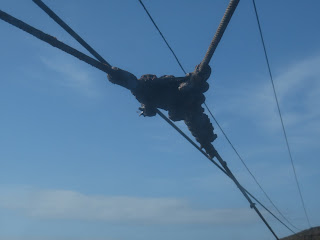




















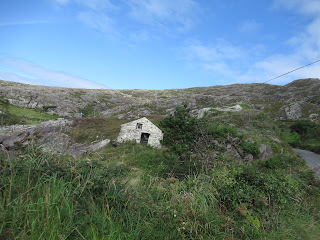

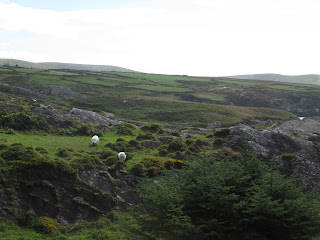








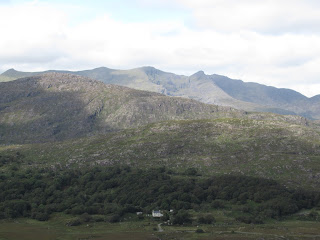
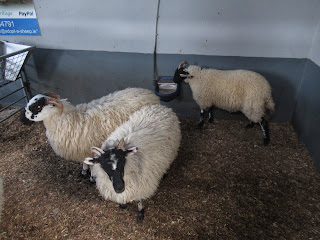




















































Did you see any people on Dursey Island? Your photos of Kate made me think that I was with you. How amazing she works with Evan. Lil Red
ReplyDeleteIndeed a day of perfect moments ! I , like Lil Red, was truly impressed at the teamwork of Evan and Kate .. 200 sheep to herd with little time to rest.. amazing. And the sheering looked equally fun to watch... I have brought my grand kiddies to our Central Experimental Farm to watch them sheer the sheep.. quite the skill ! Hugs to you both. xo
ReplyDeleteJanina and Lina,
ReplyDeleteProfuse thanks for your comment thinking you were also there watching the sheep shearing - that's always my hope when writing a post that readers will 'feel' and 'see' what we are through my photos and text.
Only saw a few people on Dursey Island but we, immediately on landing from the cable car, headed into the hills and away from the only road leading to the cable car. The sense of peace and solitude on the island was palpable. Steven chose to do more walking than I did as I was content to just sit and take in the views around me and do some knitting!
The sheep herding and shearing was a blast - one of my all time favorite memories of Ireland. I can imagine how your grand kiddies would love to see the shearing! I was amazed at how little the sheep wiggled while being sheared!
All of our Irish roots and never once have i visited. Beautiful. Thanks, Annie.
ReplyDelete